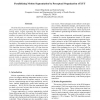Free Online Productivity Tools
i2Speak
i2Symbol
i2OCR
iTex2Img
iWeb2Print
iWeb2Shot
i2Type
iPdf2Split
iPdf2Merge
i2Bopomofo
i2Arabic
i2Style
i2Image
i2PDF
iLatex2Rtf
Sci2ools
ICPR
2004
IEEE
2004
IEEE
Parallelizing Motion Segmentation by Perceptual Organization of XYT
The front end of many motion analysis algorithms is usually a process that generates bounding boxes around each moving object, roughly segmenting the objects from the background. Processing to finely define the moving object boundary can follow, but only within these rough bounding boxes. In this paper, we consider a method that exploits the structure and organization in the spatio-temporal block (XYT) of motion data to create bounding boxes around moving objects. This method has been shown to be robust with respect to illumination changes,noise, and occlusion events. This algorithm, however, begins with a 3D edge detection step across a sequence of images, which is a time consuming process. We have mapped this 3D edge detection to run on any MPI enabled parallel computer, thus achieving significant speedups especially for large image frames. We present results on sequences of various sizes and lengths from the recently formulated Human ID Gait Challenge Problem dataset. We compare th...
| Added | 09 Nov 2009 |
| Updated | 09 Nov 2009 |
| Type | Conference |
| Year | 2004 |
| Where | ICPR |
| Authors | Daniel Majchrzak, Sudeep Sarkar |
Comments (0)

